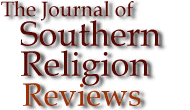

Laborers in the Vineyard of the Lord: The Beginnings of the AME Church in Florida, 1865-1895. By Larry Eugene Rivers and Canter Brown, Jr. Gainesville: University Press of Florida, 2001. 256 + xx pp. 6 X 9. 59 b&w photos, 2 maps, notes, bibliography, index. Cloth $34.95. Reviewed by Lee L. Willis, III, for the Journal of Southern Religion.
|
|
|
| "As the turn of the century loomed, exigencies created by Plessy v. Ferguson and the tightening vise of Jim Crow forced the church to adopt the attitude of accommodation and compromise." | |
|
|
According to Rivers and Brown, both professors at Florida A&M University, the clergy of the AME Church dominated the state's public affairs during the height of Reconstruction in the early 1870s. Needing the votes of African Americans, Republicans brokered with the AME clergy who made political activism a priority. The church helped steamroll important education legislation and other programs for freedmen but the influence came at a price as jealousy and factionalism soon opened deep fissures among the denomination's leaders. By the 1880s, the church chose to put its weight behind the moral crusade of temperance rather than politics. Also contributing to this change of focus was the return to white Democratic rule as well as disenchantment with the corruption of state government.
The authors also touchupon the important issue of class in the AME experience. As William E. Montgomery argued in Under Their Own Vine and Fig Tree, tensions between the rational theology of northern ministers and the emotionalism of southern freed men and women divided the denomination. Yet in Florida it was a southern-born bishop, Daniel A. Payne, as well as a burgeoning middle class who alienated their brethren by insisting "to bring order, symmetry, and quiet respectability to the church" (141). A native of South Carolina, Bishop Payne served the Florida AME Church for nearly twenty years before his ordination in 1884. Instead of a rift between northerners and southerners, the fault lines in Florida ran between town and country. Whereas congregations in Tallahassee and Jacksonville built impressive temples, the rural churches resembled frontier-meeting houses. Furthermore, the cost of the episcopacy drew the ire of many African Methodists as the urban bishops earned the pejorative moniker, the "black princes" (149).
A paucity of sources constrained the authors' ability to ask big questions about the role of gender. Though Rivers and Brown skillfully employ newspapers and WPA questionnaires, their scant data inhibited such a portrait of the female laity. As a result, they constructed their narrative around the principal male leaders of the church. While the authors do mention, "the enormous assistance provided by lay women and evangelists," they offer little commentary on the function of femininity (193). A gap in the sources likely caused this omission. It is disappointing nonetheless, as recent work by Evelyn Brooks Higginbotham, Laura Edwards, and Ted Ownby (to name a few) demonstrated the important part that gender played in both religion and power relationships in the New South.
Rivers and Brown end their scope of inquiry at 1895, the fortieth anniversary of the AME Church in Florida. This four-decade scope is logical as it follows an arc in the growth of the church from early promise and political clout in the 1860s and 1870s to factionalism and ill repair in the 1880s and 1890s. As the turn of the century loomed, exigencies created by Plessy v. Ferguson and the tightening vise of Jim Crow forced the church to adopt the attitude of accommodation and compromise. With the era of Reconstruction political activism now a distant memory, the church entered an unfortunate period of retrenchment.
Laborers in the Vineyard of the Lord should be valued as a contribution to the literature of Florida studies as well as southern religious history. Though the book will not redirect the historiography, historians can benefit from its dense, fact-filled narrative. Yet the complex milieu of Florida's religious experience in the nineteenth century still eludes historians. Future scholarship will benefit from a broader, multi-denominational scope as well as innovative, interdisciplinary methodology. Such an approach will certainly bring readers closer to the lay experience and afford a more satisfying discussion of what it meant to be an African Methodist in Florida.
Lee L. Willis, III, Florida State University
© 1998-2003 by The Journal of Southern Religion. All rights reserved. ISSN 1094-5234